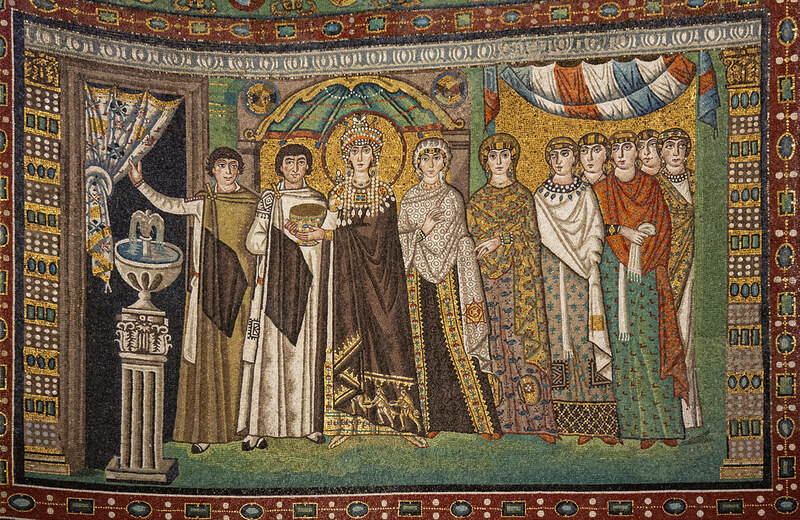Mosaics
Mosaics offer a method of promoting imperial power for female rulers as they were often overseen by women. Churches and religious artwork existed primarily in the realm of female patronage, as these projects were taken on by aristocratic women. Therefore, they had a prominent say in their depiction of imperial mosaics that appeared in churches. The general public would experience these divine moments of beauty and godly intervention when they attended church and would connect these intense devotions to not only God, but also the imperial rulers. In this way, imperial women were depicted as equals to the imperial man through artistic attributes, scale, and visual relationships. Furthermore, the color of mosaics were essential to the creation of power. The majestic purple of their imperial dress and the ethereal gold of their halos and jewels demonstrated visual connections to royalty and rulers that were chosen by God. The fact that empresses were depicted in the same manner as emperors solidified their equal status in artistic representation and therefore in the minds of the general public.
Empress Theodora is depicted holding up the eucharist chalice, declaring herself as the patron of the San Vitale Basilica. Her purple imperial robes and her crown with the pendilia demonstrate that she is the ruler and an equal ruler to Justinian, who wears a matching ensemble. Another feature that consolidates the connection between the two rulers is that they face each other across the nave of the church. In this way, both rulers are of equal importance in the procession of the eucharist. The stance of Theodora glorifies her image as she appears imposing and visually connected to saints and angels. The richness of the mosaic and the quality of the craftsmanship distinguish Theodora as an equal partner to Justaninan and serve as an ever present reminder of her divine power.
The most important church in the Byzantine Empire depicts the empress Zoe giving a donation to Christ alongside her husband Constantine IX. The depiction of the co-rulers is an interesting one because of their unique circumstances. Zoe assumed rulership after the death of her first husband, who she was accused of conspiring against, and was able to choose her second husband. Therefore, their depiction with Christ in Hagia Sophia is to not only establish credibility for herself but also for her marriage. Furthermore, her beauty is emphasized despite her age of seventy. She is depicted without wrinkles on her face, with an imposing stature, large eyes, and golden hair. Zoe’s immense beauty is connected to divinity because only a ruler that was directly chosen by God could be so singular in appearance. Her devotion to God and their obvious connection is emphasized which demonstrates her right to rule and her overall piety.

